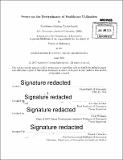Essays on the determinants of healthcare utilization
Author(s)
Easterbrook, Kathleen Fehring; Gruber, Jonathan
DownloadFull printable version (8.382Mb)
Other Contributors
Massachusetts Institute of Technology. Department of Economics.
Advisor
Jonathan Gruber and Heidi Williams.
Terms of use
Metadata
Show full item recordAbstract
The first chapter investigates how hospital mergers affect technology adoption and utilization. I analyze the mergers of five for-profit hospital chains in a difference-in-difference framework, comparing markets in which two or more of the merging chains operated prior to the mergers to markets in which zero or one chain operated. The estimates suggest that treated markets gained 5.1 to 7.1 technologies as a result of the mergers. An increase of 5.1 technologies represents 39% of the increase in technology levels in these markets during the post-merger period. I find little evidence that utilization increased post-merger, but there is some evidence that utilization of certain technologies increased when they were more widely available. In the second chapter, I investigate whether the hospitals that were part of the merging chains achieved cost savings through local consolidation and economies of scale resulting from the formation of a large hospital system. Exploiting variation in how the hospitals were affected by the mergers, I find no evidence that local consolidation led to lower expenditures. However, I document that expenditures at hospitals that were part of the merging chains declined by 14% after the mergers, suggesting there may be economies of scale for a large, national chain. Taken together, the results imply limited cost efficiencies from local consolidation for hospitals that are part of a larger system. The final chapter, co-authored with Jonathan Gruber, examines how individuals respond to changes in copays for physician office visits using data from over 1500 employer-sponsored insurance plans with 1.5 million enrollees. Within our sample, there are 171 separate changes in copays for physician office visits, and we use a difference-in-difference methodology to evaluate their effect. We estimate the elasticity of office visit spending with respect to patient contribution is -0.13. Individuals with chronic conditions appear to be less sensitive to the price of office visits than individuals without chronic conditions. We find suggestive evidence that these effects compound, as copay increases correspond with declines in spending on labs and radiology and a larger decrease in total spending than office visit spending alone.
Description
Thesis: Ph. D., Massachusetts Institute of Technology, Department of Economics, 2015. The 3rd chapter is co-authored with Jonathan Gruber. Cataloged from PDF version of thesis. Includes bibliographical references (pages 107-111).
Date issued
2015Department
Massachusetts Institute of Technology. Department of EconomicsPublisher
Massachusetts Institute of Technology
Keywords
Economics.